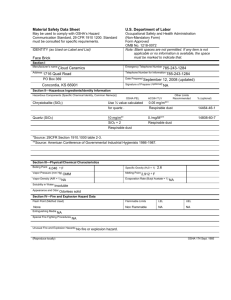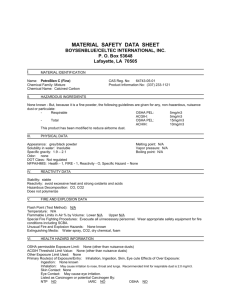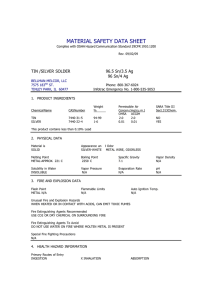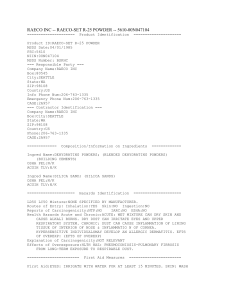SA-15NF Precolor SDS - Advanced Composites
advertisement
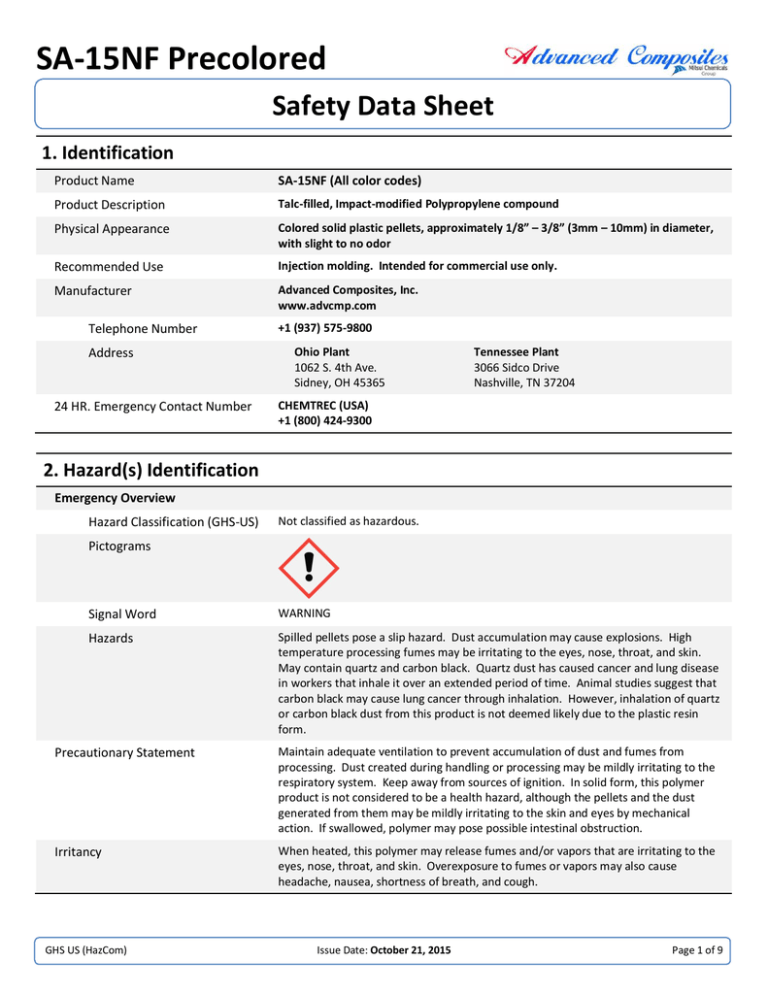
SA-15NF Precolored Safety Data Sheet 1. Identification Product Name SA-15NF (All color codes) Product Description Talc-filled, Impact-modified Polypropylene compound Physical Appearance Colored solid plastic pellets, approximately 1/8” – 3/8” (3mm – 10mm) in diameter, with slight to no odor Recommended Use Injection molding. Intended for commercial use only. Manufacturer Advanced Composites, Inc. www.advcmp.com Telephone Number Address 24 HR. Emergency Contact Number +1 (937) 575-9800 Ohio Plant 1062 S. 4th Ave. Sidney, OH 45365 Tennessee Plant 3066 Sidco Drive Nashville, TN 37204 CHEMTREC (USA) +1 (800) 424-9300 2. Hazard(s) Identification Emergency Overview Hazard Classification (GHS-US) Not classified as hazardous. Pictograms Signal Word WARNING Hazards Spilled pellets pose a slip hazard. Dust accumulation may cause explosions. High temperature processing fumes may be irritating to the eyes, nose, throat, and skin. May contain quartz and carbon black. Quartz dust has caused cancer and lung disease in workers that inhale it over an extended period of time. Animal studies suggest that carbon black may cause lung cancer through inhalation. However, inhalation of quartz or carbon black dust from this product is not deemed likely due to the plastic resin form. Precautionary Statement Maintain adequate ventilation to prevent accumulation of dust and fumes from processing. Dust created during handling or processing may be mildly irritating to the respiratory system. Keep away from sources of ignition. In solid form, this polymer product is not considered to be a health hazard, although the pellets and the dust generated from them may be mildly irritating to the skin and eyes by mechanical action. If swallowed, polymer may pose possible intestinal obstruction. Irritancy When heated, this polymer may release fumes and/or vapors that are irritating to the eyes, nose, throat, and skin. Overexposure to fumes or vapors may also cause headache, nausea, shortness of breath, and cough. GHS US (HazCom) Issue Date: October 21, 2015 Page 1 of 9 SA-15NF Precolored Safety Data Sheet 3. Composition/Information on Ingredients Component(s) CAS Registry # Weight % Ethylene-propylene-copolymer 9010-79-1 † Talc (Magnesium Silicate) 14807-96-6 † Quartz (Crystalline silica, component of talc) 14808-60-7 Carbon Black (Pigment) 1333-86-4 † Chromium oxide, Cr2O3 (Pigment) 1308-38-9 † Titanium Dioxide, TiO2 (Pigment) 13463-67-7 † 1.0 † Proprietary information Comments The listed components (if present in this product) are encapsulated in a thermoplastic resin with limited release under normal conditions of use, transportation, and storage. Increased release may occur when the resin (or material/product manufactured from it) is subject to grinding, polishing, excessive heat, or other processes which enhance the potential for the generation of particulates, fumes, and/or vapors. A qualified health specialist should evaluate the specific potential for release under user’s conditions of handling of this material. 4. First-Aid Measures Most Important Effects Molten plastic can cause severe thermal burns. First Aid Skin Contact If skin irritation or rash occurs, rinse or wash affected areas. Seek medical advice/attention if irritation persists. If contacted by molten polymer, cool immediately with cold or ice water. Do not attempt removal of any solidified material without medical assistance. Get medical attention immediately. In the case of most burns, it may be advisable to allow solidified material to slough off on its own. Attempted removal may lead to more damage of the skin and underlying tissue. If removal is indicated (e.g. solidified material is located on a critical part of the hand or face), removal with mineral oil is recommended. Eye Contact If contacted by molten polymer, immediately flush eyes with plenty of cool water for at least 15 minutes. Do not rub eyes. Get medical attention immediately. Ingestion If product is ingested, contact a physician or the Poison Control Center as appropriate whenever any foreign object is swallowed. Rinse mouth. Do NOT induce vomiting. Inhalation If irritation or dizziness occurs, evacuate to fresh air and remain at rest in a comfortable position for breathing. Seek medical advice/attention. Acute and Delayed Effects Skin Contact Prolonged exposure may cause irritation, rash, or allergic skin reaction. Wash hands, other exposed areas, and clothing regularly. Seek medical advice if conditions persist. Eye Contact, Inhalation Dust and fumes may cause irritation to the eyes, nose, throat, and lungs. Flush eyes with water or get to fresh air. Seek medical attention if irritation persists. GHS US (HazCom) Issue Date: October 21, 2015 Page 2 of 9 SA-15NF Precolored Safety Data Sheet Ingestion May cause intestinal obstruction. 5. Fire-Fighting Measures Flammable Properties Flammable Class Class 1 – Must be heated to burn Please use caution when handling material near open flame. Material will ignite when exposed to direct flame, but will not burn readily. Flash Point Not established. Autoignition Temperature >280°C (>536°F), ASTM E659 Protective Equipment for Firefighters Suitable Extinguishing Media Fire Fighting Procedures Fire fighters should wear self-contained breathing apparatus in the positive pressure mode with a full-face piece when there is a possibility of exposure to smoke, fumes, or hazardous decomposition products. Water spray Dry chemical Foam Carbon dioxide If possible, water should be applied as a spray from a fogging nozzle since this polymer is a surface burning material. The application of high velocity water will spread the burning layer. NOTE: Individuals should perform only those fire-fighting procedures for which they have been trained. Hazardous Combustion Products Carbon, oxides of carbon, oxides of nitrogen, water, acrolein, formaldehyde, other aldehydes, ketones, alcohols, fatty acids, methane, ethane, acetylene, other organic vapors and fumes. 6. Accidental Release Measures Personal Precautions Restrict access to only authorized personnel wearing appropriate personal protective equipment. Spilled pellets pose a slip hazard. Environmental Precautions Keep spilled material away from heat, sparks, and open flames. Ensure adequate ventilation. Protective Equipment Wear safety glasses meeting the specifications of OSHA 29CFR 1910.133/ ANSI Standard Z87.1 where no contact with the eye is anticipated. Chemical safety goggles meeting the specifications of OSHA 29CFR 1019.133/ ANSI Standard Z87.1 should be worn whenever there is a possibility of contact with the eyes. General Procedures Where spills are possible, a comprehensive spill release response plan should be developed and implemented. Plastic pellets are listed as “significant materials” by US EPA (40CFR 122.26(b)(12)) and may need to be discussed in an application for a storm water discharge permit. Small Spill Small spills can be swept up and recycled or disposed of. GHS US (HazCom) Issue Date: October 21, 2015 Page 3 of 9 SA-15NF Precolored Safety Data Sheet Large Spill Wear appropriate respiratory protection and protective clothing as described in Section 8. Contain spilled material. Transfer to secure containers. In the event of an uncontrolled release of this material, the user should determine if the release is reportable under the applicable laws and regulations. 7. Handling & Storage Handling The handling of pellets in both loading and unloading operations as well as fabrication may cause dust to be formed and necessary precautions for personal protection (see Section 8) should be taken. When transferring pellets, precautions such as grounding and bonding can prevent the buildup of static electricity. Safe Storage Store in a dry place away from moisture, excessive heat, and sources of ignition. Have emergency equipment for fires and spills readily available. Incompatible Materials Do not store with strong oxidizing agents such as nitric acid, sulfuric acid, halogens, hydrogen peroxide, and chlorinating agents. Hygiene Wash hands before eating, drinking, smoking, or using the restroom Further Advice Keep containers closed and/or covered when not in use. 8. Exposure Controls & Personal Protection Engineering Controls Ensure all national/local regulations are observed. Ensure adequate ventilation, especially in confined areas. Emergency eye wash fountains and safety showers should be available in the immediate vicinity of any potential exposure. Personal Protective Equipment Skin Wear heat protective gloves and clothing if there is a potential for contact with heated material. Eyes and Face Wear safety glasses meeting the specifications of OSHA 29CFR 1910.133/ ANSI Standard Z87.1 where no contact with the eye is anticipated. Chemical safety goggles meeting the specifications of OSHA 29CFR 1019.133/ ANSI Standard Z87.1 should be worn whenever there is a possibility of contact with the eyes. Respiratory Use a NIOSH-approved respirator whenever exposure may exceed established Occupational Exposure Limits. GHS US (HazCom) Issue Date: October 21, 2015 Page 4 of 9 SA-15NF Precolored Safety Data Sheet Occupational Exposure Limits Component Talc (Magnesium Silicate) (14807-96-6) Classification Exposure Limit 3 ACGIH TWA 2 mg/m (particulate matter containing no asbestos and <1% crystalline silica, respirable fraction) ACGIH Category Not classifiable as a Human Carcinogen containing no asbestos fibers NIOSH IREL (TWA) 2 mg/m3 (containing no asbestos and <1% quartz-respirable dust) ILDH 1,000 mg/m3 (containing no asbestos and <1% quartz) AGCIH TWA 0.025 mg/m3 (respirable fraction) ACGIH Category A2 – Suspected Human Carcinogen NIOSH REL (TWA) 0.05 mg/m3 (respirable dust) IDLH 50 mg/m3 (respirable dust) OSHA PEL (STEL) 250 mppcf/%Si02+5, 10mg/m3/%Si02+2 ACGIH TWA 3.5 mg/m3 (respirable fraction) ACGIH Category Confirmed animal carcinogen with unknown relevance to humans NIOSH REL (TWA) 3.5 mg/m3 1.5 3.5 mg/m3 (Carbon black in presence of Polycyclic aromatic) US IDLH 1750 mg/m3 OSHA TWA 3.5 mg/m3 Chromium oxide (Cr2O3) (1308-38-9) ACGIH TWA 0.05 mg/m3 0.5 (Cr II & Cr III Compounds) 0.05 (Cr VI Water Soluble) OSHA PEL (TWA) 1 (metal) 0.5 (Cr II & Cr III Compounds) 0.005 (Cr VI Compounds) Titanium dioxide (TiO2) (13463-67-7) OSHA TWA 15 mg/m3 Total dust ACGIH TWA 10 mg/m3 NIOSH IDLH 5,000 mg/m3 Quartz (Crystalline Silica) (14808-60-7) Carbon Black (1333-86-4) 9. Physical & Chemical Properties Appearance Colored plastic pellets, approximately 1/8” – 3/8” (3mm – 10mm) in diameter Odor Slight to no odor pH Not applicable Melting Point 160~205°C (320~401°F) Boiling Point None Flash Point No data available Evaporation Rate No data available Flammability Will ignite when exposed to direct flame, but will not burn readily. Upper/Lower Explosive Limit Not explosive Vapor Pressure No data available Vapor Density No data available GHS US (HazCom) Issue Date: October 21, 2015 Page 5 of 9 SA-15NF Precolored Safety Data Sheet Relative Density 0.89 – 1.30 Water Solubility Not soluble Auto-ignition Temperature >280°C (>536°F), ASTM E659 Decomposition Temperature No data available Viscosity Not applicable The physical property data above are typical values and should not be construed as a product specification. 10. Stability & Reactivity Reactivity Stable under recommended storage conditions (See Section 7) Conditions to Avoid Avoid excessive heat, sparks, or open flame. Keep away from strong oxidizing agents. Materials to Avoid May burn or react violently with fluorine/oxygen mixtures with 50~100% fluorine. Chemical Stability May be decomposed by strong oxidizing agents such as nitric acid, sulfuric acid, halogens, hydrogen peroxide, and chlorinating agents. Hazardous Polymerization Not likely under recommended storage conditions. Hazardous Decomposition Combustion may produce carbon, oxides of carbon, oxides of nitrogen, water, acrolein, formaldehyde, other aldehydes, ketones, alcohols, fatty acids, methane, ethane, acetylene, other organic vapors and fumes. 11. Toxicological Information Primary Route(s) of Exposure Eye and Skin Contact Potential Health Effects Eye Contact May cause irritation from mechanical abrasion. Skin Pellets not expected to cause skin irritation. Contact with molten material may cause thermal burns. Inhalation Not a likely route of exposure. Process fumes may cause irritation. Ingestion May pose a choking hazard if swallowed. Immediate Effects Exposure during handling and processing may aggravate disorders of the eyes, skin, gastrointestinal tract, and respiratory system. Delayed Effects There is no information on the long term health effects of exposure to this product or the fumes and dust that may result from the handling and processing of it. GHS US (HazCom) Issue Date: October 21, 2015 Page 6 of 9 SA-15NF Precolored Safety Data Sheet Acute Toxicity Component Measured Toxicity Carbon Black (1333-86-4) LD50: > 8000 mg/kg (Oral, Rat) Chromium Oxide (Cr2O3) (1308-38-9) ATE: 100.00 mg/kg body weight (Oral) ATE: 1.50 mg/l/4h (Dust/Mist) Titanium Dioxide (13463-67-7) LD50: > 5000 mg/kg (Oral, Rat) LC50: > 6.82 mg/L (Inhaled Dust/Mist, Male Rat) Quartz (14808-60-7) LD50: > 5000 mg/kg (Oral, Rat) LD50: > 5000 mg/kg (Dermal, Rat) Carcinogenicity OSHA, IARC, and NTP have listed carbon black (pigment used in dark colors) and quartz (crystalline silica, naturally occurring in talc in low percentages) as known human carcinogens. Titanium dioxide and chromium oxide have been identified as suspected or confirmed human carcinogens. These components are essentially bound to the plastic matrix and are unlikely to contribute to workplace exposure under recommended processing conditions. Reproductive Toxicity Not classified Medical Conditions Aggravated There are no known medical conditions aggravated by exposure to this product. However, certain sensitive individuals with respiratory impairments may be affected by exposure to components in the processing emissions. 12. Ecological Information Ecotoxicity No data is available on the adverse environmental effects of this product. Ecotoxicity is expected to be low due to the limited water solubility of polymers. However, birds, fish, and other wildlife may eat pellets that may obstruct their intestinal tracts. Persistence and degradability This material is generally inert and insoluble and is not expected to have any adverse effect on the environment. This material may deteriorate by a number of mechanisms including photo- and thermo-oxidative degradation. Photodegraded polymers are also more easily biodegraded. Bioaccumulation potential No data available. Mobility in soil No data available. Other adverse effects No data available. 13. Disposal Considerations Product Disposal GHS US (HazCom) All recovered material should be packaged, labeled, transported, and disposed of or reclaimed in conformance with applicable laws and regulations and in conformance with good engineering practices. Reclaim where possible. Issue Date: October 21, 2015 Page 7 of 9 SA-15NF Precolored Safety Data Sheet 14. Transport Information This product is NOT regulated as a hazardous material/dangerous good for all forms of transportation In Accordance with DOT Not regulated for transport In Accordance with IMDG Not regulated for transport In Accordance with IATA Not regulated for transport UN Number None UN Proper Shipping Name None Transport Hazard Class(es) None Packing Group None Special precautions to be aware of or comply with None 15. Regulatory Information United States SARA TITLE III (Superfund Amendments and Reauthorization Act)* Fire No Pressure No Reactivity No Acute No Chronic No 302/304 This product does not contain chemicals regulated under SARA 302/304. 311/312 Hazard Categories This product does not meet the criteria of any SARA hazard categories. 313 Toxic Release This product does not contain any chemicals listed under SARA 313. * Title III Notes: This product contains no SARA “toxic chemicals” above threshold levels. State Regulations California Known to the state of California to cause cancer: CAS Registry Component 1333-86-4 Carbon Black (Airborne, unbound particles of respirable size)* 14808-60-7 Quartz (Airborne particles of respirable size)* * Note: The listed component(s) contained in this compound (if any) are encapsulated in a thermoplastic resin with limited release under normal conditions of use, transportation, and storage. See Section 3 for comments on content and release. GHS US (HazCom) Issue Date: October 21, 2015 Page 8 of 9 SA-15NF Precolored Safety Data Sheet Massachusetts New Jersey Pennsylvania May contain the following chemicals listed as “Right to Know” in these states: CAS Registry Component 1333-86-4 Carbon Black* 1308-38-9 Chromium Oxide* 13463-67-7 Titanium Dioxide* 14807-96-6 Talc (Magnesium Silicate)* 14808-60-7 Quartz* * Note: The listed component(s) contained in this compound (if any) are encapsulated in a thermoplastic resin with limited release under normal conditions of use, transportation, and storage. See Section 3 for comments on content and release. International Regulation All ingredients of this compound are listed on the following inventories or are exempt from listing: Country Australia Canada China European Union Japan Korea New Zealand United States General Comments Notification Listing AICS DSL IECS EINECS ENCS/ISHL ECL NZIoC TSCA The regulatory information presented here should not necessarily be considered as all-inclusive. Other local, state, federal, and international regulations may also apply. 16. Other Information Revision Date October 21, 2015 Prepared By Advanced Composites, Inc. Manufacturer Disclaimer The information presented herein has been obtained from sources believed to be reliable. However, because of the possibility of human or mechanical error by our sources, Advanced Composites Inc., or others, Advanced Composites Inc. does not guarantee the accuracy, adequacy, or completeness of any information, and is not responsible for any errors or omissions or for any results obtained from the use of such information. We assume no liability or responsibility, expressed or implied, for errors or omissions of any kind, and no warranties or merchantability or fitness, expressed or implied, is made or is to be implied. Consequently, each user should review the information to determine whether it is adequate and appropriate to all aspects of your intended use of this material. END OF DOCUMENT GHS US (HazCom) Issue Date: October 21, 2015 Page 9 of 9
